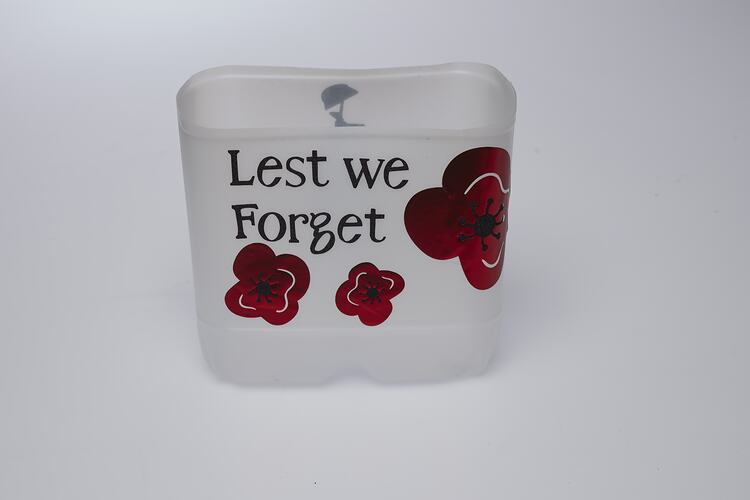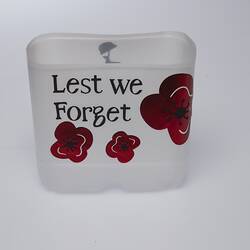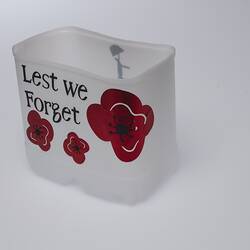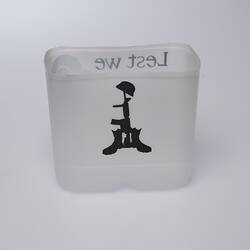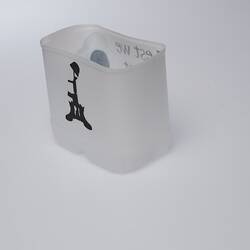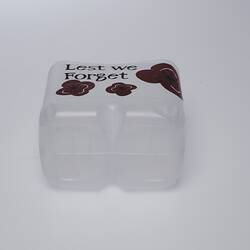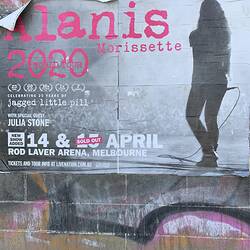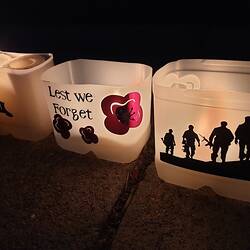Summary
One of a set of three plastic candle lanterns created by Alison Cox as part of her family's participation in the #lightupthedawn for Anzac Day, at their home in Belmont, Geelong on 25 April 2020 during the COVID-19 lockdown.
Alison made these candle lanterns from plastic, three-litre milk containers and adhered paper cut-out motifs of soldiers, military equipment, poppies and the words 'Lest We Forget'. A candle was placed in each lantern and placed in their driveway while they gathered around a fire pit to listen to the Dawn Service broadcast.
Physical Description
Lanterns are made from plastic two litre milk bottle containers with cut-out motifs in different types of paper glued to the front and back. This lantern has a black image of a vertical rifle with helmet resting at top and a pair of boots at bottom on one side and poppies and words attached on the other.
Significance
Statement of Historical Significance:
This collection provides an insight into how families and communities embraced the Dawn Service at Home call-out to recognise Anzac Day on 25 April 2020 during the COVID-19 lockdown in Australia. Anzac Day 2020 will never be forgotten. For the first time since the first Anzac Day commemoration in 1916, people could not gather together. Instead, they stood in home driveways, held candles and poppies, displayed their own family photographs, remembering and reflecting privately on the lives lost and the tragedy of war.
The candle lanterns are an example of domestic creativity and innovation, using disposable objects (plastic milk cartons) decorated with poppies and military motifs to create lanterns. The family (mum, dad and three children) all participated in their own backyard commemoration at dawn, lighting a fire around which to gather and light the candles. Photographs were taken by family member documenting the event which took place in suburban Geelong and one of the children wrote a description of the event. This collection thus encompasses the experiences, perceptions and voices of children, represents regional Victoria in its georgraphic location, demonstrates how families collectively act to participate in national events, domestic creativity, and a direct connection to the Australian Defence force is also present, with the father an active member.
More Information
-
Collection Names
-
Collecting Areas
-
Maker
Mrs Alison Cox, Belmont, Greater Geelong, Victoria, Australia, April 2020
-
Used By
Mr Damien Cox, Belmont, Greater Geelong, Victoria, Australia, 25 apr 2020
-
Used By
Miss Kathleen Cox, Belmont, Greater Geelong, Victoria, Australia, 25 april 2020
-
Inscriptions
'Lest We Forget'
-
Classification
-
Category
-
Discipline
-
Type of item
-
Object Dimensions
163 mm (Width), 100 mm (Depth), 141 mm (Height)
The plastic has distorted on cutting so measurements are not consistent across the whole item.
-
Keywords
Crafts, Making Do, Lighting, World War I, 1914-1918, Families, Homes, Homecrafts, Candles
